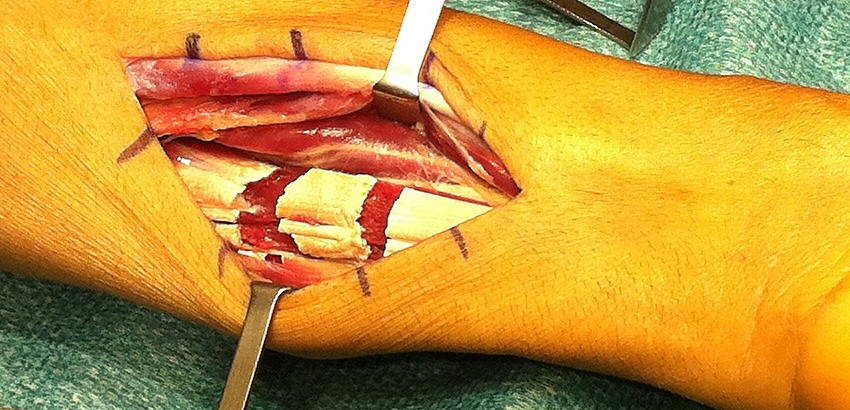Not all spastic patients will need surgery.
The goal of surgery varies according to the severity of the deformity, the requirements and desires of the patient, and sometimes the local resources in terms of after care. Indications are discussed with the patient, family, and the whole team involved in the patient care.
Restoring the balance
Surgery is ideally performed to improve function of the upper limb, and thus allow the hand to reach, to grasp, to manipulate, and to release. This functional surgery usually involves several procedures, in order to decrease the tone of the muscles which are hyperactive or contracted, and to reinforce the muscles which are weak or paralysed.
But this may not be possible in patients with severe impairments, such as severe paralysis, abnormal movements, bed confined patients, severe communication (cognition*) problems. In some cases, surgery will be helpful to correct a deformity in order to facilitate nursing or hygiene, sometimes in order to decrease pain. Some patients only wish for a cosmetic improvement (correction of a severely flexed elbow, or wrist).
Reduce spasticity: selective neurectomy
Procedures aiming at reducing spasticity consist in partial resection of the motor nerves* of the spastic muscles. The involved nerves are identified during the operation with the help of electrical stimulation, and part of their motor branches are cut and removed (usually 2/3 of the branches).
This is referred to as selective neurectomy. As a result, the muscle is less spastic, and weaker. No immobilization is required after this procedure. Physiotherapy is usually started after two weeks.
Release muscle contractures
Many different procedures are used to release muscle contractures:
- Detachment of the involved muscle from its proximal insertion on the bone. This is used mainly for the muscles which flex the wrist (wrist flexors), and the fingers (finger flexors).The procedure is referred to as “medial epicondylar release”, or “SCAGLIETTI-PAGE” technique.
- Distal section of the muscle tendon: “tenotomy”. This simple procedure is often performed for the tendons of the wrist flexors: (flexor carpi radialis FCR, and mostly flexor carpi ulnaris FCU)
-
 Lengthening the muscle at the tendon/muscle junction (fractional lengthening) or within the tendon (Z lengthening).
Lengthening the muscle at the tendon/muscle junction (fractional lengthening) or within the tendon (Z lengthening). - The STP technique consists in lengthening the finger flexors in severely contracted fingers (clenched fist) with little or no movement.
After surgery, the limb is usually protected by a splint for 4 weeks, and physiotherapy is started immediately, except for the “Z” technique, where it is only started after 4 weeks.
Restore function of a paralyzed muscle: tendon transfer
Procedures aiming at restoring the function of a paralyzed muscle are known as tendon transfers. The technique consists in rerouting an active muscle by bringing its tendon into the tendon of a paralyzed muscle in order to restore its function. The most frequent tendon transfers in the upper limb are performed to restore active extension of the wrist. After the surgery, full immobilization of the part is required for four weeks, then physiotherapy is required, usually three times a week for two months. It is an important part of the success of this technique.
Other procedures
Other surgical procedures may be utilized in specific cases:
- ARTHRODESIS
Arthrodesis consists in fusing a joint. This results in permanent stiffness of the joint. It is useful to correct a very severe deformity, especially in non-functioning hands. It is utilized mainly at the wrist level, and it can be partial, leaving some motion, or complete, leaving no motion in extension and flexion, but preserving rotation. It is also performed sometimes in the thumb to correct a very deformed or very unstable joint. It is not indicated in the elbow, and very seldom at the shoulder level.
- ARTHROLYSIS
Arthrolysis means surgical release of a stiff joint. It may be necessary prior to, or at the same time as other procedures when a joint has become rigid as a result of spasticity. After the release, intensive physiotherapy is required, otherwise the stiffness is likely to recur.
- JOINT STABILIZATION
In children some joints may become hyperlax as a result of the muscle imbalance. This occurs mostly at the level of the fingers, resulting in the so-called “swan neck deformity” or at the thumb level, resulting in hyperextension of the middle joint (metacarpo-phalangeal joint). Stabilization consists in reinforcing the joint ligaments (“ligamentoplasty”), preventing abnormal movement but preserving normal movements.






